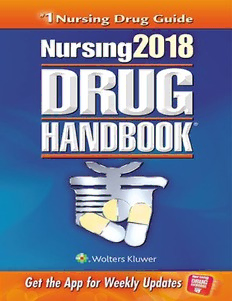
Nursing2018 Drug Handbook PDF
Preview Nursing2018 Drug Handbook
38th Edition Nursing2018 DRUG HANDBOOK ® Chief Nurse: Anne Dabrow Woods, DNP, RN, CRNP, ANP-BC, AGACNP-BC Publisher: Jay Abramovitz Clinical Director: Joan M. Robinson, RN, MSN Clinical Project Manager: Lorraine Hallowell, RN, BSN, RVS Clinical Editors: Janet Rader, RN, BSN; Dorothy Terry, RN; Leigh Ann Trujillo, RN, MSN Product Director: David Moreau Senior Product Manager: Diane Labus Editor: Karen C. Comerford Copy Editor: Mary T. Durkin Editorial Assistants: Jeri O’Shea, Linda K. Ruhf Art Director: Elaine Kasmer Designer: Joseph John Clark Senior Production Project Manager: Cynthia Rudy Manufacturing Manager: Kathleen Brown Production Services: Aptara, Inc. © 2018 by Wolters Kluwer. All rights reserved. This book is protected by copyright. No part of this book may be reproduced or transmitted in any form or by any means, including as photocopies or scanned-in or other electronic copies, or utilized by any information storage and retrieval system without written permission from the copyright owner, except for brief quotations embodied in critical articles and reviews. Materials appearing in this book prepared by individuals as part of their official duties as U.S. government employees are not covered by the above-mentioned copyright. To request permission, please contact Wolters Kluwer at Two Commerce Square, 2001 Market Street, Philadelphia, PA 19103, via email at [email protected], or via website at lww.com (products and services). 9 8 7 6 5 4 3 2 1 Printed in China NDH38-010517 ISSN: 0273-320X ISBN-13: 978-1-4963-5359-7 ISBN-10: 1-4963-5359-5 ISBN-13: 978-1-4963-5360-3 (Canada) ISBN-10: 1-4963-5360-9 (Canada) This work is provided “as is,” and the publisher disclaims any and all warranties, express or implied, including any warranties as to accuracy, comprehensiveness, or currency of the content of this work. This work is no substitute for individual patient assessment based upon healthcare professionals’ examination of each patient and consideration of, among other things, age, weight, gender, current or prior medical conditions, medication history, laboratory data, and other factors unique to the patient. The publisher does not provide medical advice or guidance, and this work is merely a reference tool. Healthcare professionals, and not the publisher, are solely responsible for the use of this work, including all medical judgments and for any resulting diagnosis and treatments. Given continuous, rapid advances in medical science and health information, independent professional verification of medical diagnoses, indications, appropriate pharmaceutical selections and dosages, and treatment options should be made and healthcare professionals should consult a variety of sources. When prescribing medication, healthcare professionals are advised to consult the product information sheet (the manufacturer’s package insert) accompanying each drug to verify, among other things, conditions of use, warnings, and side effects and identify any changes in dosage schedule or contraindications, particularly if the medication to be administered is new, infrequently used, or has a narrow therapeutic range. To the maximum extent permitted under applicable law, no responsibility is assumed by the publisher for any injury and/or damage to persons or property, as a matter of products liability, negligence law or otherwise, or from any reference to or use by any person of this work. LWW.com Contents Anatomy of a monograph Contributors and consultants How to use Nursing2018 Drug Handbook ® Quick guide to special symbols, logos, and highlighted terms Guide to abbreviations General information 1. Drug actions, interactions, and reactions 2. Drug therapy across the lifespan 3. Safe drug administration 4. Selected therapeutic drug classifications Alphabetical listing of drugs by generic name New drugs Appendices 1. Avoiding common drug errors: Best practices and prevention 2. Pregnancy risk categories: The FDA’s Final Rule 3. Controlled substance schedules 4. Abbreviations to avoid (The Joint Commission) 5. Pediatric drugs commonly involved in drug errors 6. Elder care medication tips 7. Prescription drug abuse: Identifying and treating toxicity 8. Understanding biosimilar drugs 9. Nursing process: Patient safety during drug therapy 10. Serotonin syndrome: What you should know to protect your patient 11. Tumor lysis syndrome: A life-threatening emergency 12. Antidiarrheals: Indications and dosages 13. Antidotes: Indications and dosages 14. Selected biologicals and blood derivatives: Indications and dosages 15. Common combination drugs: Indications and dosages 16. Vaccines and toxoids: Indications and dosages 17. Vitamins and minerals: Indications and dosages 18. Antacids: Indications and dosages 19. Laxatives: Indications and dosages 20. Additional OTC drugs: Indications and dosages 21. Do not use: Dangerous abbreviations, symbols, and dose designations (ISMP Canada) 22. Decision tree: Deciding about medication administration 23. Canadian National Drug Schedules 24. Safe disposal of unused drugs: What patients need to know 25. Therapeutic drug monitoring guidelines 26. Less commonly used drugs: Indications and dosages 27. Additional new drugs: Indications and dosages Index Contributors and consultants Janine Barnaby, BS, RPh, BCOP Manager, Hospital Outpatient Pharmacy Lehigh Valley Hospital Allentown, PA David Bruch, BS, PharmD Assistant Lecturer University of Wyoming School of Pharmacy Laramie Lawrence Carey, PharmD Associate Chair, Department of Pharmacy Practice Temple University School of Pharmacy Philadelphia, PA Jason C. Cooper, PharmD Clinical Pharmacist, MUSC Drug Information Center Medical University of South Carolina Charleston Lana Gettman, PharmD Assistant Professor Harding University College of Pharmacy Searcy, AR Toshal Hallowell, PharmD Pharmacist Edward M. Kennedy Community Health Center Worcester, MA Lauren Hazelton, PharmD Pharmacy Manager Walgreens Pharmacy Haddon Township, NJ AnhThu Hoang, PharmD Professor Sheridan College Brampton, Ontario
